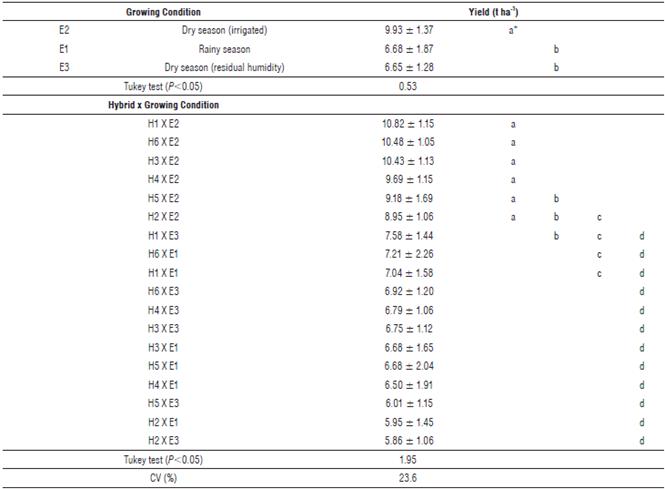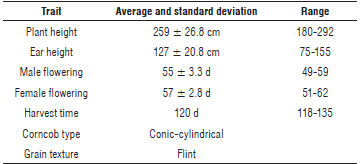Introduction
Flint yellow maize is a crop of significant importance in Ecuador. During the rainy season of 2016, farmers sowed roughly 192,000 ha of flint yellow maize, with an average yield of 5.5 t ha-1 (Castro, 2016). Maize in Ecuador is a strategic crop for food security because of its multiple products and by-products, which are mainly used in the poultry, fish, and dairy feed industries.
Although this kind of maize production has increased in recent years in Ecuador, going from 540,000 t in 2002 to 1,730,000 t in 2015 (MAG, 2015), more high yielding hybrids that are adapted to the growing conditions in Ecuador are needed. Most of the maize (84% of the production area) is sown in December and January at the beginning of the rainy season (Aguilar et al., 2015). The rainy season lasts three to five months, and the rainfall is irregularly distributed during this period (MAG, 2015).
Accordingly, the objective of the National Maize Breeding Program of INIAP is to develop and release high yielding hybrids that are adapted to the local growing conditions, with resistance to the principal foliar diseases of this crop.
Materials and methods
The single-cross maize hybrid "INIAP H-603 Superior" was obtained in 2010, crossing selected lines generated by the Maize Breeding Program (MBP) of the National Institute for Agricultural Research (INIAP) and lines introduced by the International Center for Maize and Wheat Improvement (CIMMYT), Colombia (Alarcón et al., 2016).
origin of parental lines
The female line POB.3.F4. 27-1-1-1 was developed by the MBP at the Experimental Station Portoviejo (EEP). It was derived from the Population POB.3 in 1994 using diallelic crossing between six genotypes: INIAP-541, INIAP-542, INIAP-526, Pool 26 selección sequía (CIMMYT), Pool 18 selección sequía precoz (CIMMYT), and Pacific 9205 (private company). After four cycles of mass selection, 256 inbred lines (S1) were developed with self-pollination. The lines were advanced to S4 and evaluated for adaptability and combining ability. This line was selected because of its good agronomic traits, combining ability and high yield. The male line CML-451 was introduced in 2007 from CIMMYT, Colombia. These lines are maintained at EEP by hand (plant to plant pollination), with controlled open pollination.
Experimental design and statistical analysis
This experiment was conducted in the provinces of Manabi (Santa Ana, Tosagua, Jipijapa), Guayas (Balzar, El Empalme), Los Rios (Mocahe, Valencia) and Loja (Zapotillo, Pindal, Paltas). Ten experimental hybrids, including "INIAP H-603 Superior", and five commercial checks (INIAP H-553, INIAP H-601, INIAP H-602, DE-KALB-1596, and DEKALB-7088) were evaluated using a randomized complete block design with three replicates in 29 locations (trials) from 2010 to 2013. To establish the differences between the hybrids, an analysis of variance and significance tests were carried out per location and combined (McIntosh, 1983; González et al., 2010; Moore and Dixon, 2015) with the statistical package INFOSTAT v. 2015 (Di Rienzo et al., 2015). A Tukey t-test (P<0.05) was used to determine the differences in the mean yield between the hybrids, growing conditions and interactions. The model used to estimate yield was: Yij = ^+Gi+Aj+(GA) ij+Bk(j)+Eijk, where: Yij = average performance of the i-th hybrid obtained in the j-th environment; \i = effect of the general median; Gi = effect of the i-th hybrid; Aj = effect of the j-th environment; (GA)ij = effect of the interaction between the i-th genotype and the j-th environment; Bk(j) = effect of the k-th repetition on the j-th environment, and Eijk = randomized effect of the experiment error associated with the i-th genotype on the j-th environment and k-th repetition.
The stability of the hybrids was estimated based on Eberhart and Russel's (1966) criteria (Lin et al., 1986). To evaluate the stability, the locations were grouped based on the three main maize Ecuadorian growing conditions: rainfall (20 trials), with irrigation during the dry season (four trials), and with water deficits (sustained moisture) during the dry season (five trials). The planting for the dry season occurred in June and July and, for the rainy season, in December and January. The experiment plots consisted of two rows (5 m long) with a distance between rows of 0.80 m, and 0.20 m between plants, for a population density of 62,500 plants ha-1.
Agronomic management
The experiments were planted by hand. The fertilization and phytosanitary control of the crop were carried out according to Villavicencio and Zambrano (2009). The response of the hybrid to the prevalent foliar diseases: leaf blight (Exserohilum turcicum), rust (Puccinia sorghi), and leaf spot (Curvularia lunata) was evaluated under natural infection conditions, along with the five commercial hybrids used as controls at the EEP, from 2010 to 2013. The disease symptoms were scored after silking (reproductive stage R4), based on a 1 to 5 scale developed by CIMMYT (1995), where 1 was no symptoms and 5 was complete infection. The plant and ear (cob) heights, male and female flowering time, and grain yield were also evaluated as described by CIMMYT (1995), while the corncob type and grain texture were scored according to IBPGR (1991).
Results and discussion
Agronomic characteristics
The plant architecture and phenology of "INIAP H-603 Superior" are similar to other maize hybrids developed by INIAP (Tab. 1). The index between the ear (cob) and the plant height (AM/AP) and male and female flowering times are important traits for breeders because they contribute to lodging resistance and complete grain filling of the cob. The index AM/AP for INIAP H-603 Superior (0.5) and flowering time (55 and 57 d) were good values for lodging resistance and grain filling. These values agree with those reported by Gordon and Deras (2017) for maize in Mesoamerica (AM/AP = 0.5, female flowering = 54 d, male flowering = 57 d), as well as the AM/AP index value reported by Vera et al. (2013), who evaluated eight hybrids in four locations in the central area of the Ecuadorian lowlands. Both authors observed variations caused by environmental effects, as seen in the present study.
Resistance to major foliar diseases
"INIAP H-603 Superior" was rated 3 (moderate) for leaf blight (E. turcicum), rated 1 (no symptoms) for rust (P. sorghi), and rated 2 (mild) for leaf spot (C. lunata) as shown in Table 2. These are significant foliar diseases in the provinces of Manabi, Guayas and Los Rios (Villavicencio and Zambrano, 2009). The new hybrid showed equal or a better response (lower values) to foliar disease incidence than the other commercial hybrids. P. sorghi (1 to 8%) and E. turcicum (1 to 30%) were reported for Pergamino, Argentina by Parisi et al. (2014), who concluded that maize genotypes responded differently to these epiphytes. Vera et al. (2013) reported an average disease incidence of 3.31 and 2.44% for leaf spot and leaf blight, respectively, with an incidence not greater than 20% for maize hybrids evaluated in the Ecuadorian lowlands.
Yield performance
The combined analysis of variance for yield showed highly significant differences between the hybrids, environments and interactions (Tab. 3 and 4). A combined mean analysis showed that there were four ranges of significance for the hybrids, where "INIAP H-603 Superior", with 8.48 t ha-1 was the most stable (bi closest to 1) and shared the same range of significance for yield with DEKALB-1596 and INIAP H-601, with 8.20 t ha-1 and 7.95 t ha-1, respectively.
TABLE 3 Average yield, standard deviation, and yield stability of "INIAP H603 Superior" and five commercial maize hybrids evaluated in 29 locations in the Ecuadorian lowlands from 2010 to 2013.

* Means and standard deviations followed by the same letter do not differ statistically according to the Tukey’s range test (P<0.05).
** Values close to 1 are the most stable, according to Eberhart and Russel (1966).
TABLE 4 Average yield and standard deviation (t ha1) of the maize hybrids according to the growing conditions and hybrid X growing condition interaction evaluated in 29 locations in the Ecuadorian lowlands from 2010 to 2013.

* Means and standard deviations followed by the same letter do not differ statistically according to the Tukey's range test (P<0.05).
H1 = INIAP H-603 Superior, H2 = INIAP H-553, H3 = INIAP H-601, H4 = INIAP H-602, H5 = DEKALB-7088, H6 = DEKALB-1596.
There were significant differences between the yield obtained with irrigation during the dry season (9.93 t ha-1) and the yields obtained during the rainy season (6.68 t ha-1) and the dry season with residual humidity (6.65 t ha-1) (Tab. 4). This suggests that, during the rainy season, this crop may not receive the amount of water required by the plant to express its yield potential at the appropriate time. These results support the concept that high maize yields are associated with production under irrigation (Zambrano et al., 2017) and coincide with the observations of Arellano et al. (2011) and Caicedo et al. (2017), who found that irrigation with high yield hybrids resulted in a differential or yield potential of 5.0 and 7.0 t ha-1, respectively.
Stability analysis
The genotype X environment interaction (GxE) is an important input in the evaluation and development of new maize hybrids based on yield (Zambrano et al., 2017) and resistance to diseases (Parisi et al., 2014), where climatic, soil and management variations produce a significant effect on the differentiation of hybrids. This was first proposed by Finlay and Wilkinson (1963), Eberhart and Russell (1966), and Zobel et al. (1988), but nowadays there are several models for estimating GxE, which are widely used in maize, such as the reliability based on differences in yield with commercial controls (Camargo et al., 2002) or the additive main effects and multiplicative interaction (AMMI) model (Caicedo et al., 2017).
The Eberhart and Russel (1966) criterion for stability evaluates the relationship between environmental conditions and yield, where linear relationships are more stable. Alejos et al. (2006) showed how the Eberhart and Russel method is useful for evaluating genotypes with favorable or unfavorable responses to changing environments. In this study, "INIAP H-603 Superior" changed linearly with the change in the environment, with a regression coefficient (bi) of 0.98 and R 2 of 0.84 (Tab. 3), indicating that it is a genotype with good stability. These values are similar to those reported for new maize hybrids in Panama (Camargo et al., 2002). Hybrids with bi values greater than 1, such as DEKALB-7088, which showed a bi of 1.26 and R2 of 0.57, are very sensitive to environmental changes. In addition, "INIAP H-603 Superior" had high yields in all tested environments. These kinds of genotypes should have a good response to high-input agriculture (Sabaghania et al., 2006).
Conclusions
The crossing of domestic (INIAP lines) and CIMMYT lines has allowed the development of a high yielding maize hybrid, with an average of 8.48 t ha-1, that is adapted to the varying local growing conditions. "INIAP H-603 Superior" is a hybrid well suited for the Ecuadorian lowlands, with resistance to the three principal foliar diseases: leaf blight (Exserohilum turcicum), rust (Puccinia sorghi), and leaf spot (Curvularia lunata), and good yield stability (bi = 0.98). The greatest yield potential of the new hybrid (10.82 t ha-1) was obtained with irrigation during the dry season.

















